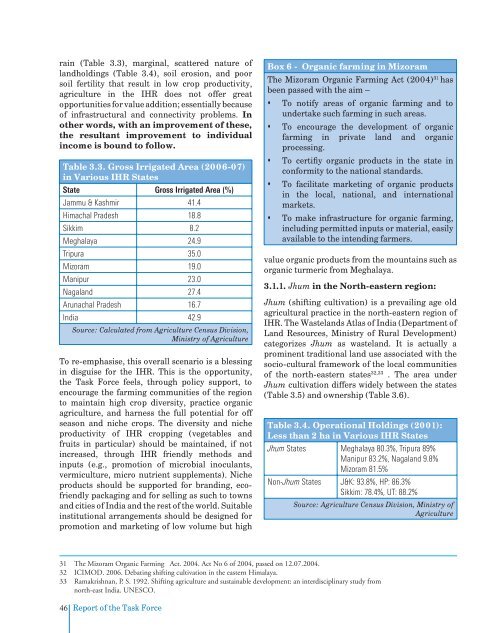Task Force Report - Govind Ballabh Pant Institute of Himalayan ...
Task Force Report - Govind Ballabh Pant Institute of Himalayan ...
Task Force Report - Govind Ballabh Pant Institute of Himalayan ...
You also want an ePaper? Increase the reach of your titles
YUMPU automatically turns print PDFs into web optimized ePapers that Google loves.
ain (Table 3.3), marginal, scattered nature <strong>of</strong><br />
landholdings (Table 3.4), soil erosion, and poor<br />
soil fertility that result in low crop productivity,<br />
agriculture in the IHR does not <strong>of</strong>fer great<br />
opportunities for value addition; essentially because<br />
<strong>of</strong> infrastructural and connectivity problems. In<br />
other words, with an improvement <strong>of</strong> these,<br />
the resultant improvement to individual<br />
income is bound to follow.<br />
Table 3.3. Gross Irrigated Area (2006-07)<br />
in Various IHR States<br />
State Gross Irrigated Area (%)<br />
Jammu & Kashmir 41.4<br />
Himachal Pradesh 18.8<br />
Sikkim 8.2<br />
Meghalaya 24.9<br />
Tripura 35.0<br />
Mizoram 19.0<br />
Manipur 23.0<br />
Nagaland 27.4<br />
Arunachal Pradesh 16.7<br />
India 42.9<br />
Source: Calculated from Agriculture Census Division,<br />
Ministry <strong>of</strong> Agriculture<br />
To re-emphasise, this overall scenario is a blessing<br />
in disguise for the IHR. This is the opportunity,<br />
the <strong>Task</strong> <strong>Force</strong> feels, through policy support, to<br />
encourage the farming communities <strong>of</strong> the region<br />
to maintain high crop diversity, practice organic<br />
agriculture, and harness the full potential for <strong>of</strong>f<br />
season and niche crops. The diversity and niche<br />
productivity <strong>of</strong> IHR cropping (vegetables and<br />
fruits in particular) should be maintained, if not<br />
increased, through IHR friendly methods and<br />
inputs (e.g., promotion <strong>of</strong> microbial inoculants,<br />
vermiculture, micro nutrient supplements). Niche<br />
products should be supported for branding, ec<strong>of</strong>riendly<br />
packaging and for selling as such to towns<br />
and cities <strong>of</strong> India and the rest <strong>of</strong> the world. Suitable<br />
institutional arrangements should be designed for<br />
promotion and marketing <strong>of</strong> low volume but high<br />
Box 6 - Organic farming in Mizoram<br />
The Mizoram Organic Farming Act (2004) 31 has<br />
been passed with the aim –<br />
• To notify areas <strong>of</strong> organic farming and to<br />
undertake such farming in such areas.<br />
• To encourage the development <strong>of</strong> organic<br />
farming in private land and organic<br />
processing.<br />
• To certifiy organic products in the state in<br />
conformity to the national standards.<br />
• To facilitate marketing <strong>of</strong> organic products<br />
in the local, national, and international<br />
markets.<br />
• To make infrastructure for organic farming,<br />
including permitted inputs or material, easily<br />
available to the intending farmers.<br />
value organic products from the mountains such as<br />
organic turmeric from Meghalaya.<br />
3.1.1. Jhum in the North-eastern region:<br />
Jhum (shifting cultivation) is a prevailing age old<br />
agricultural practice in the north-eastern region <strong>of</strong><br />
IHR. The Wastelands Atlas <strong>of</strong> India (Department <strong>of</strong><br />
Land Resources, Ministry <strong>of</strong> Rural Development)<br />
categorizes Jhum as wasteland. It is actually a<br />
prominent traditional land use associated with the<br />
socio-cultural framework <strong>of</strong> the local communities<br />
<strong>of</strong> the north-eastern states 32,33 . The area under<br />
Jhum cultivation differs widely between the states<br />
(Table 3.5) and ownership (Table 3.6).<br />
Table 3.4. Operational Holdings (2001):<br />
Less than 2 ha in Various IHR States<br />
Jhum States Meghalaya 80.3%, Tripura 89%<br />
Manipur 83.2%, Nagaland 9.8%<br />
Mizoram 81.5%<br />
Non-Jhum States J&K: 93.8%, HP: 86.3%<br />
Sikkim: 78.4%, UT: 88.2%<br />
Source: Agriculture Census Division, Ministry <strong>of</strong><br />
Agriculture<br />
31 The Mizoram Organic Farming Act. 2004. Act No 6 <strong>of</strong> 2004, passed on 12.07.2004.<br />
32 ICIMOD. 2006. Debating shifting cultivation in the eastern Himalaya.<br />
33 Ramakrishnan, P. S. 1992. Shifting agriculture and sustainable development: an interdisciplinary study from<br />
north-east India. UNESCO.<br />
46<br />
<strong>Report</strong> <strong>of</strong> the <strong>Task</strong> <strong>Force</strong>

















